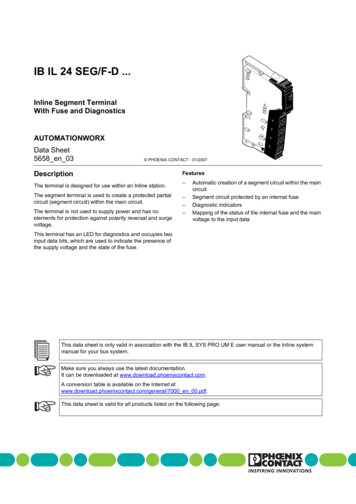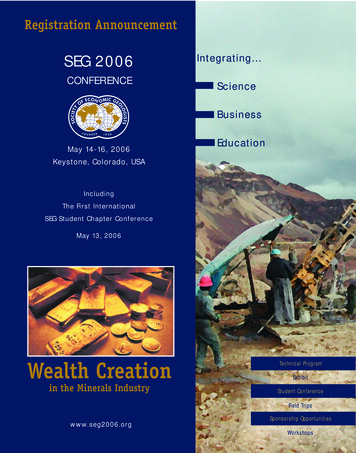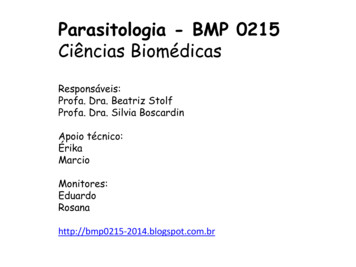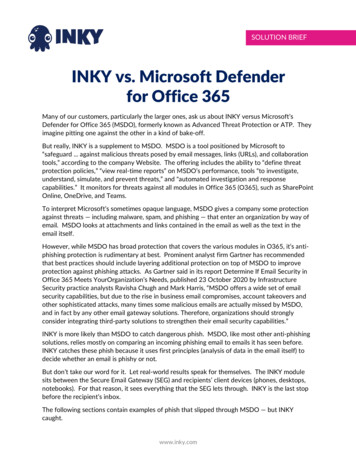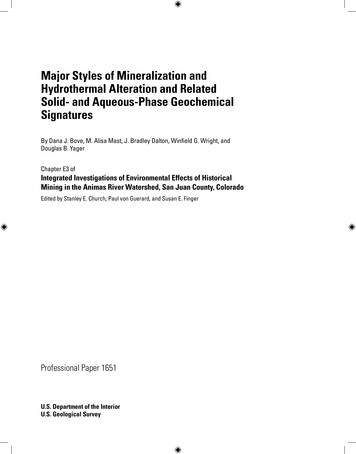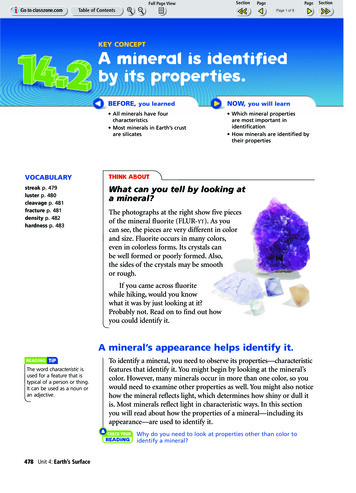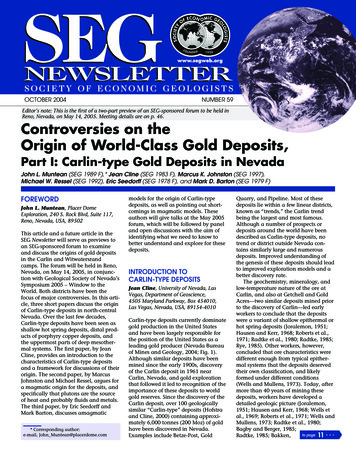
Transcription
SEGNEWSLETTERSOCIETY OF ECONOMIC GEOLOGISTSOCTOBER 2004NUMBER 59Editor’s note: This is the first of a two-part preview of an SEG-sponsored forum to be held inReno, Nevada, on May 14, 2005. Meeting details are on p. 46.Controversies on theOrigin of World-Class Gold Deposits,Part I: Carlin-type Gold Deposits in NevadaJohn L. Muntean (SEG 1989 F),* Jean Cline (SEG 1983 F), Marcus K. Johnston (SEG 1997),Michael W. Ressel (SEG 1992), Eric Seedorff (SEG 1978 F), and Mark D. Barton (SEG 1979 F)FOREWORDJohn L. Muntean, Placer DomeExploration, 240 S. Rock Blvd, Suite 117,Reno, Nevada, USA, 89502This article and a future article in theSEG Newsletter will serve as previews toan SEG-sponsored forum to examineand discuss the origins of gold depositsin the Carlin and Witwatersrandcamps. The forum will be held in Reno,Nevada, on May 14, 2005, in conjunction with Geological Society of Nevada’sSymposium 2005 – Window to theWorld. Both districts have been thefocus of major controversies. In this article, three short papers discuss the originof Carlin-type deposits in north-centralNevada. Over the last few decades,Carlin-type deposits have been seen asshallow hot spring deposits, distal products of porphyry copper deposits, andthe uppermost parts of deep mesothermal systems. The first paper, by JeanCline, provides an introduction to thecharacteristics of Carlin-type depositsand a framework for discussions of theirorigin. The second paper, by MarcusJohnston and Michael Ressel, argues fora magmatic origin for the deposits, andspecifically that plutons are the sourceof heat and probably fluids and metals.The third paper, by Eric Seedorff andMark Barton, discusses amagmatic* Corresponding author:e-mail, John Muntean@placerdome.commodels for the origin of Carlin-typedeposits, as well as pointing out shortcomings in magmatic models. Theseauthors will give talks at the May 2005forum, which will be followed by paneland open discussions with the aim ofidentifying what we need to know tobetter understand and explore for thesedeposits.INTRODUCTION TOCARLIN-TYPE DEPOSITSJean Cline, University of Nevada, LasVegas, Department of Geoscience,4505 Maryland Parkway, Box 454010,Las Vegas, Nevada, USA, 89154-4010Carlin-type deposits currently dominategold production in the United Statesand have been largely responsible forthe position of the United States as aleading gold producer (Nevada Bureauof Mines and Geology, 2004; Fig. 1).Although similar deposits have beenmined since the early 1900s, discoveryof the Carlin deposit in 1961 nearCarlin, Nevada, and gold explorationthat followed it led to recognition of theimportance of these deposits to worldgold reserves. Since the discovery of theCarlin deposit, over 100 geologicallysimilar “Carlin-type” deposits (Hofstraand Cline, 2000) containing approximately 6,000 tonnes (200 Moz) of goldhave been discovered in Nevada.Examples include Betze-Post, GoldQuarry, and Pipeline. Most of thesedeposits lie within a few linear districts,known as “trends,” the Carlin trendbeing the largest and most famous.Although a number of prospects ordeposits around the world have beendescribed as Carlin-type deposits, notrend or district outside Nevada contains similarly large and numerousdeposits. Improved understanding ofthe genesis of these deposits should leadto improved exploration models and abetter discovery rate.The geochemistry, mineralogy, andlow-temperature nature of the ore atCarlin, and also at Getchell and GoldAcres—two similar deposits mined priorto the discovery of Carlin—led earlyworkers to conclude that the depositswere a variant of shallow epithermal orhot spring deposits (Joralemon, 1951;Hausen and Kerr, 1968; Roberts et al.,1971; Radtke et al., 1980; Radtke, 1985;Rye, 1985). Other workers, however,concluded that ore characteristics weredifferent enough from typical epithermal systems that the deposits deservedtheir own classification, and likelyformed under different conditions(Wells and Mullens, 1973). Today, aftermore than 40 years of mining thesedeposits, workers have developed adetailed geologic picture (Joralemon,1951; Hausen and Kerr, 1968; Wells etal., 1969; Roberts et al., 1971; Wells andMullens, 1973; Radtke et al., 1980;Bagby and Berger, 1985;to page 11 . . .Radtke, 1985; Bakken,
OCTOBER 2004 No 59.from1SEG NEWSLETTERControversies on the Origin of World-Class Gold Deposits (Continued)118o116o117o115oNorthern Carlin trendJerrittCanyonGetchelltrendTwin Creeksr liCaWellsnt41odrenWinnemuccaBattle okreTonkin SpringsatNevadandreGold tersFIGURE 1. Digital elevation model of northern Nevada showing locations of major mineralbelts and districts. Carlin-type deposits (circles), other significant Au, Ag, Pb, Zn, or Cudeposits (crosses), eastern limit of the Roberts Mountain allochthon, cities (small circles),and highways (black lines). Inset shows the distribution of Carlin-type deposits in the northern Carlin trend. Taken from Hofstra et al. (2003).1990; Arehart et el., 1993; Hofstra,1994; Kuehn and Rose, 1992; 1995;Arehart, 1996; Stenger et al., 1998;Hofstra et al., 1999; Hofstra and Cline,2000; Ressel et al., 2000b; Bettles, 2002;Thompson et al., 2002; Emsbo et al.,2003; Heitt et al., 2003; Kesler et al.,2003). Most of those who work onCarlin-type deposits would agree thatthese deposits exhibit significant uniquecharacteristics that are distinct fromtypical epithermal deposits, yet a comprehensive and widely accepted geneticmodel remains elusive.Carlin-type ores are distinctive fromtypical epithermal ores because theyform replacement bodies with structuraland stratigraphic controls, contain primary gold that is restricted to ionic substitution and submicron-sized grains inarsenian pyrite, and exhibit alterationthat is subtle but dominated bydecarbonatization of silty calcareoushost rocks. Ore mineralogy, textures,fluid inclusion studies, and numericalmodels (Hofstra et al., 1991; Arehart,1996; Woitsekhowskaya and Peters,1998; Stenger et al., 1998; Cline andHofstra, 2000; Hofstra and Cline, 2000;Kesler et al., 2003) indicate that golddid not precipitate in response to boiling or fluid cooling, as in many epithermal systems, but instead precipitated inresponse to sulfidation of iron in thehost rock or in a second, iron-bearingfluid. Although a few studies havedetermined pressure and temperatureconditions during gold precipitationand sources of ore fluid components,these studies have not converged on agenetic model and, instead, have led toa proliferation of genetic models thatcan be sorted into three majorclassifications: (1) epizonal plutonscontributed heat and possibly fluidsand metals (Sillitoe and Bonham, 1990;Henry and Boden, 1998; Henry andRessel, 2000); (2) meteoric fluid circulation resulting from crustal extensionscavenged and precipitated metals withor without contributions of heat fromwidespread magmatism (Ilchik andBarton, 1997; Emsbo et al., 2003); and(3) metamorphic fluids from deep ormidcrustal levels, possibly with a magmatic contribution, transported andprecipitated metals (Seedorff, 1991;Hofstra and Cline, 2000).The difficulty in sorting out the genesis of Carlin-type deposits is related tothe complex geologic history of northern Nevada and specific features of thedeposits. For example, minerals that arepart of the main ore stage (quartz,pyrite, illite, and locally dickite) are finegrained and volumetrically minor. Inaddition, northern Nevada has undergone multiple diagenetic andhydrothermal events that producedmany of the same minerals as thoseassociated with the Carlin-type deposits,and these events were overprinted by orsuperimposed on the main ore stage.The geology of many deposits is furthercomplicated by supergene alterationthat oxidized the orebodies and mobilized gold, contributing to misinterpretations about deposit genesis during theearly years of mining. All these complications make it difficult to analyze mineralized samples and learn about themain ore stage associated with thedeposits. Bulk analyses of mineralizedsamples simply produce a result that isa mixture of several events. Analysis ofmineral separates and microanalysis ofpyrite, quartz, and fluid inclusions canproduce results related to the main orestage; however, such analyses requirepainstaking petrography to unravelmineral parageneses and to distinguishgold-related pyrite, quartz, and silicateminerals from pre- or postore minerals.A major advance in the last severalyears has been resolution of the age offormation of Nevada’s Carlin-typedeposits. A late Eocene age has beenestablished by Rb-Sr dating of galkhaite,a late ore stage sulfosalt mineral fromthe Getchell deposit (39.0 2.1 Ma;Tretbar et al., 2000) and the Rodeo deposit (39.8 0.6 Ma; Arehart et al., 2003)located on the northernCarlin trend. These reto page 12 . . .sults demonstrate that
12.SEG NEWSLETTERfrom11No 59 OCTOBER 2004Controversies on the Origin of World-Class Gold Deposits (Continued)mineralization on the Carlin andGetchell trends is approximately thesame age, and available age data frompre- and postore igneous rocks (cf. Hofstraet al., 1999; Arehart et al., 2003) collectively indicate that all deposits formedduring a fairly narrow time intervalbetween about 42 and 36 Ma. Establishing this timing has been criticallyimportant because the tectonic regimeduring deposit formation can now beincorporated into a genetic model.Au-rich porphyry copper (BinghamCanyon, Copper Canyon), skarn(Fortitude, McCoy), and distal-disseminated deposits (Lone Tree, Cove,Hilltop) were also forming in Nevadaand Utah during the late Eocene(Doebrich and Theodore, 1996;Theodore, 1998, 2000; Parry et al.,2001). The distal-disseminated depositsshare many features with Carlin-typedeposits and have led to various geneticinterpretations regarding these twodeposit types. The U.S. GeologicalSurvey distinguishes distal-disseminateddeposits from Carlin-type deposits anddefines them as disseminated gold andsilver occurring mainly in sedimentaryrocks distal to porphyry copper deposits,skarns, and/or polymetallic vein systems (Cox, 1992; Hofstra and Cline,2000). As pointed out by Hofstra andCline (2000), the distinction is important in that Carlin-type deposits havemuch larger gold endowments than distal-disseminated deposits as currentlyclassified. This distinction is challengedin the next paper by Johnston andRessel, and is the current focal point ofcontroversy surrounding the genesis ofCarlin-type deposits.CARLIN-TYPE AND DISTALDISSEMINATED Au-AgDEPOSITS: RELATED DISTALEXPRESSIONS OF EOCENEINTRUSIVE CENTERS IN NORTHCENTRAL NEVADAMarcus K. Johnston, Victoria Resources(US) Inc., 605 Cortney Dr., Elko,Nevada, USA, 89801, andMichael W. Ressel, Newmont MiningCorporation, P.O. Box 69, Golconda,Nevada, USA, 89414IntroductionSedimentary rock-hosted, disseminatedgold deposits are major gold producers,with Nevada production alone exceeding 210 tonnes (7 Moz) in 2000. Most ofthese deposits in Nevada occur alongthe Carlin, Battle Mountain-Eureka,and Getchell trends, and include thegiant Betze-Post and Gold Quarrymines, as well as Carlin, Cortez, Cove,Deep Star, Genesis, Getchell, Lone Tree,Marigold, Meikle, Pipeline, and TwinCreeks deposits, among others (Fig. 1).Sedimentary rock-hosted, disseminated gold deposits have been separated into two specific classes: Carlintype and distal-disseminated Au-Agdeposits. Although distal-disseminateddeposits share many physical and geochemical characteristics with Carlintype deposits, they are differentiatedfrom Carlin-type deposits based onmore definitive chemical, spatial,and/or temporal links with porphyryrelated deposits. We propose a continuum between Carlin-type and distal-disseminated deposits in the Great Basin,with most or all deposits occurring asperipheral, relatively shallow components of large, complex, magmatichydrothermal systems.BackgroundWhereas the intrusion-related origin ofdistal-disseminated deposits is rarelydisputed (e.g., Theodore 2000; Hofstraand Cline, 2000; Johnston, 2000, 2003),that of the Carlin-type is highly controversial. Relative to distal-disseminateddeposits, Carlin-type deposits generallyform at lower temperatures, are commonly not spatially associated withmetamorphic aureoles of coeval intrusive stocks, lack strong associations withAg and base metals, and have isotopiccompositions that suggest evolved meteoric fluids and sedimentary rocks assources for ore-forming components.Northern Nevada also contains lateEocene Au Cu porphyry deposits, aspointed out in the first paper. All thesedeposits fall within a belt of Eocenecalc-alkaline magmatism, and mostCarlin-type deposits are spatially associated with large Eocene magmatic centers (Christiansen and Yeats, 1992;Henry and Ressel, 2000).In several districts in Nevada, including Battle Mountain, Bullion-Rain, andMcCoy, deposits are zoned along majorfault systems from proximal Au Cuporphyry and/or skarn deposits, throughintermediate polymetallic occurrences,to more distal distal-disseminateddeposits. Many workers (e.g., Sillitoeand Bonham, 1990; Seedorff, 1991;Theodore, 1998; Henry and Ressel,2000; Theodore, 2000; Johnston, 2003)postulate that these deposits representclassically zoned magmatic-hydrothermal systems, based on spatial and temporal associations, but these observations typically lack data to support thisinference. Recently, Johnston (2003)used fluid inclusion, metal zoning, andisotopic data to link Eocene magmatism, Au-Ag skarn ore at McCoy, andCarlin-type–distal-disseminated depositsore at nearby Cove. At McCoy-Cove,Battle Mountain, and the Carlin trend,exposed Eocene intrusions are shallowexpressions of much larger intrusions atdepth that are thought to have suppliedheat and probably metals to Carlintype and distal-disseminated deposits(Henry and Ressel, 2000; Ressel et al.,2000a, b; Theodore, 2000; Johnston,2003).Other studies indicate magmatic tiesfor some deposits considered to be classic Carlin-type. Deposits in the Carlintrend formed contemporaneously withmultiple stages of spatially coincidentEocene magmatism between 42 and 36Ma (Henry and Ressel, 2000; Ressel etal., 2000a, b). Subvolcanic textures inore-bearing Eocene dikes support arguments that the deposits formed at shallower depths than those typical of theporphyry-skarn environment of, forexample, the Battle Mountain district,where well-defined alteration and metalzoning exist (Theodore, 2000). A directmagmatic tie is indicated at Deep Star,in the northern Carlin trend, where δDand δ18O of ore-stage kaolinite varyfrom near the magmatic-metamorphicfield in the center of the orebody towardexchanged mid-Tertiary meteoric wateron its margins (Heitt et al., 2003). TheGetchell deposit, for which the Getchelltrend is named, is considered by manyto be a “classic” Carlin-type deposit,because it shows no apparent relationships with Eocene magmatism otherthan a temporal link. However, δD,δ18O, and 3He/4He from ore-relatedminerals are consistent with a magmatic (or metamorphic) component inore fluids (Hofstra and Rye, 1998;Hofstra and Cline, 2000; Cline et al.,2002, 2003).Growing evidence for magmatic connections indicate that some well-studied
OCTOBER 2004 No 59SEG NEWSLETTERCarlin-type deposits may be better classified as distal-disseminated (Johnston,2003) and that a distinction betweenthe two types of deposits is not warranted. This inference begs a simplequestion: if most or all Carlin-typedeposits in north-central Nevada arecoeval with late Eocene magmatism, atime that also includes the developmentof large Au-Ag Cu skarns with distaldisseminated deposits on their margins,13is it not possible, or even probable, thatthe lower temperature, more Au-richCarlin-type are even more distal relatives of such systems?Intrusion-related model forCarlin-type depositsFigure 2 is a conceptual model thatcombines ideas from earlier models bySillitoe and Bonham (1990) andJohnston (2003). Based principally onAgeothermal conditions and host-rocklithology, there are a number of placeswithin a sedimentary rock-hosted, goldrich, magmatic-hydrothermal systemwhere porphyry and/or skarn, polymetallic, and Carlin-type and distal-disseminated deposit orebodies can form(Fig. 2C). The model includes Carlintype and distal-disseminated deposits as distalto page 14 . . .and generally shallowBPRE-/SYN-MINERAL VOLCANICS43 to 36 Ma GRANODIORITE700-300 CFAVORABLE HOST LITHOLOGIES375-225 CCARBONATE-CEMENTED CLASTIC ROCKSSILTY/SANDY LIMESTONEMICROCRYSTALLINE LIMESTONEDOLOSTONE300-150 CPRO-GRADEFLUID FLOWUNFAVORABLE HOST LITHOLOGIESQUARTZITE, ARGILLITE, CHERT1-2 ikle /Pb-ZnGoldQuarryMikePERMISSIVE ENVIRONMENTSAu-Cu PORPHYRY /SKARNPOLYMETALLIC VEINS,MANTOS, & CHIMNEYSDEPOSITOUTLINESCARLIN-STYLE DEPOSITS2 kmFIGURE 2. Hypothetical zoning patterns related to an idealized Eocene magmatic-hydrothermal system in the Great Basin physiographicprovince, United States. A. Geology, emphasizing more favorable units based on higher permeability and/or reactivity. B. Temperatureand prograde flow regime, with fluids derived from a large magma chamber at depth. C. Possible depositional environments for variousdeposit types, based on temperature and protolith. D. Examples of Eocene gold deposit types (deposit shapes modified from Babcock etal., 1997; Bettles, 2002; Clode et al., 2002; Harlan et al., 2002; Jackson et al., 2002; Norby and Orobona, 2002; Johnston, 2003). Scale bar inA applies to all cross sections; the scale bar in D applies only to the deposit outlines.
1413No 59 OCTOBER 2004Controversies on the Origin of World-Class Gold Deposits agmQuartz CalciteLV300sin -T)ve ghtr z , hilaqu imaxro(p05rtzm1iderojasp ow-T)e, (1)qua 2 km(1)1500(2)0.5(1a)Conceptual models for Carlin-typedeposits have narrowed to three broadclasses, two of which are amagmatic:(1) surface-derived and/or basinal;(2) metamorphic (orogenic); and (3)magmatic (Fig. 3, top). All potentiallyproduce jasperoid in calcareous rockag(1a)Eric Seedorff (SEG 1978 F) andMark D. Barton (SEG 1979 F), Center forMineral Resources, Department ofGeosciences, 1040 East Fourth Street,University of Arizona, Tucson, Arizona85721-0077 USA2000Magmaticsurface-derivedwatersENIGMATIC ORIGIN OFCARLIN-TYPE DEPOSITS:AN AMAGMATIC SOLUTION?mAmagmaticAreas for future research shouldinclude the relative timing of extensionand ore formation, palinspastic reconstructions of mineralized districts,modeling of Eocene heat flow as a function of large intrusions and/or crustalextension, and isotopic constraints of orerelated minerals in the highest gradeCarlin-type deposits. As indicated by themagmatic (or metamorphic) ties forGetchell and Deep Star, high-grade, structurally controlled Carlin-type depositsmay be less influenced by shallow meteoric fluids and should be investigated tobetter characterize deeper source fluids.generally relate to intersections betweenthe deep-seated faults and other structures, principally other high-anglefaults and/or anticlines (cf. Hofstra andCline, 2000). Important deposit-scalemechanisms leading to Au depositionin Carlin-type and distal-disseminateddeposits are generally well established(e.g., Hofstra and Cline, 2000), andinclude the following: (1) fluid–wallrock reaction, causing decarbonatization, silicification, and dolomitizationof carbonate rocks and argillization ofigneous rocks; and (2) sulfidation ofreactive iron. Because these mechanisms are not sensitive to pressure,depth is not important. Ore could haveprecipitated over a great vertical (andhorizontal) range without any apparentstrong zonations, as observed in manyof the Carlin-type deposits in the Carlinand Getchell trends. On the margins oflarge magmatic-hydrothermal systems,where we propose Carlin-type depositsform, remobilization of at least somewall-rock components during mineralization cannot be ruled out, and maybe the norm. Circulation of meteoric,connate, or other fluids and the associated remobilization of wall-rock components may account for nonmagmaticsignatures of mineralizing fluids andvariable isotopic signatures for mineralizing components observed in manyCarlin-type deposits.( 4 km) components of the system.These depths are supported by a recentstudy of the Carlin trend, based on fission-track data (Hickey et al., 2003).Most Carlin-type and distal-disseminated deposits that lie within the majortrends are not direct products of shallowand relatively small (1–3 km2) porphyrystocks responsible for Au skarns of thesame age, and do not require the presence of such stocks. Instead, they arerelated to much larger (10–100 km2),underlying intrusions ( 5 km depth) ofintermediate to silicic composition andreduced character. These intrusions, ofbatholithic scale under the Carlin trendand Battle Mountain (Grauch, 1996;Rodriguez, 1998; Henry and Ressel,2000), for example, are argued to havesupplied heat and some fluids and metals to broad, overlying hydrothermalsystems, and magma to many highlevel porphyries. Eocene magmatism inand near the major trends was dominantly intrusive in character; volcanismwas relatively minor or possibly nonexistent in some areas, and may have followed main-stage mineralization(Henry and Boden, 1998; Henry andRessel, 2000; Ressel et al., 2000a).Magmatism and hydrothermal circulation were focused along deep-seatedfaults, which influenced the distributionof deposits along trends (Grauch et al.,2003). Deposits and clusters of depositsAfromPressure (bars).SEG NEWSLETTER400500600Temperature ( C)AsveinquartzmagmaticFIGURE 3. Models for Carlin-type gold deposits. Left: Sketches showing conceptual models. Arrows show movement of fluid; darker shading within arrows shows where fluids deposit quartz. Model 1 shows surface-derived waters descending down normal faults to the brittleductile transition zone then returning rphicmetamo to surface to form gold deposits. Model 2 shows metamorphic waters rising along faults. Small arrowlabeled 3 shows possible subordinate magmatic inputs to eitherc model. Model 3 shows magmatic-hydrothermal system related to multipleati water (1a). Right: Solubilities of calcite and quartz (grams/kg H2O) showingintrusions. All modelshave minor inputs of unevolved meteoricmgrfacedfor siliceous replacements for models,contrastingsupathsma all ending in formation of jasperoid (from Barton et al., 1997). Solubilities are foreriveare calculated from the data in Johnsonspure waterdandT) et al. (1992).in-ve ighrtz l, haqu imaxro(p
OCTOBER 2004 No 59SEG NEWSLETTERTABLE 1. Predictions from Models for Carlin-Type Gold DepositsAmagmaticMagmaticCharacteristic1. Surface-derivedand/or basinal2. Metamorphic(orogenic)Alteration andzoningRegional scale;weak zonationRegional scale;weak zonationA few km across;zoned aroundintrusions and highertemperature alterationRole ofmagmatismNonessentialNonessentialEssential; plutonsprovide metals andfluidPrimary sourceof materialsScavenged fromupper crust, primarilyclastic rocks ofmiogeoclineVarious, dependingon site of metamorphism, includingbase of miogeoclineMineralizing pluton;should correlate withmagma compositionPrimary sourceof heatThermal energyextracted from uppercrust by extensiondriven increases inpermeabilityMantle derived/underplatedmagmas/crustalthickeningLocal magmasTemperatures ofquartz depositionConstrained bytemperature of brittleductile transition: 350 CCould be 400 CNonspecifictypes at low temperatures by followingdifferent geochemical pathways (Fig. 3,bottom). Each hypothesis, however,makes a different set of predictions; thetypes of systems develop at fundamentally different spatial scales, and themodels imply different explorationstrategies (Fig. 4).We will not advocate a particularmodel. Our purpose, as it has been inthe past (Barton et al., 1997), is to stimulate discussion and further testing ofhypotheses to avert a rush to adopt anyparticular origin.Geologic settingHofstra and Cline (2000), Thompson etal. (2002), and Hofstra et al. (2003)have reviewed the key features ofCarlin-type deposits, including theirages. We focus here on northeasternNevada, in the vicinity of Carlin itself.The deposits formed between 42 and 36Ma, following a long period of contraction and crustal thickening of the miogeocline. The ages of deposits coincidewith the initiation of extension in thisregion, but although the region contains domains of extreme extension,the gold deposits are not centered onthose domains. The region also hasbeen the site of lacustrine depositionbefore, during, and after formation ofthe ore deposits. The ore-forming fluids3. Magmatic15such type of regional hydrothermal system (Fig. 4).In the setting of Carlin-type deposits,extension allows for and crustal heat orchanging topography drives the deepcirculation of surface-derived fluidsthrough clastic rocks in the lower parts ofthe miogeoclinal section that arereduced and have high background levels of the metals found in Carlin-typesystems (Nesbitt, 1988; Ilchik andBarton, 1997). This model predicts thatcarbonate would be leached and quartzdeposited mostly in the shallow crustnear the deposit, that ore fluids would berelatively dilute, and that the hydrothermal systems would be regional-scale features exhibiting weak zonation.Regionally, deposits would occur whereareas of rapid extension and thus largeincreases in permeability overlap withfavorable source rocks at depth. A challenge is to explain the localization ofdeposits in the structural domains thatwere not highly extended at the surface.Metamorphic (orogenic) systemsassociated with the deposits are mildlysaline, slightly acidic, and fairlyreduced.Surface-derived and/orbasinal systemsIn surface-derived or basinal models,surface, ground, and connate waters areintroduced into the developinghydrothermal system via faults, fractures, and pores. Flow begins inresponse to ambient or magmaenhanced thermal gradients, topographic effects, or burial, and fluidsflow up temperature in the early partsof their paths. In the complementarypart of the flow path, perhaps triggeredby tectonic events, fluids migrate toareas of lower pressures along structuresand strata, where they interact withother fluids and rocks, cool, and candeposit metals by any of a variety ofmechanisms. The types of metals precipitated depend on factors such as thecompositions of the surficial fluids(dilute, saline, concentrated brines), thecompositions of rocks along the heatingpath and in the reservoir, the temperature of the fluids upon release, and thenature of interactions near the site ofdeposition (Ilchik and Barton, 1997).The Viburnum trend, a MississippiValley-type Pb-Zn district, is shown toillustrate the geometry and scale of oneIn this model, Carlin-type deposits arederived from metamorphic fluids ordeep crustal and mantle sources,released by earthquakes on regionalfault systems. The deposits might beregarded as updip extensions of orogenic gold systems (e.g., Groves et al.,1998). Alternatively, the initiation ofextension might tap preexisting fluidreservoirs in the clastic part of the miogeocline (Seedorff, 1991). Figure 4 showsthe central part of the Mother Lode goldbelt, illustrating the geometry and scaleof this type of regional hydrothermalsystem.This model has similarities to theprevious one, but differs in that thetemperature of quartz vein depositionmight be higher such that Carlin-typedeposits could be rooted in large quartzveins. A challenge is to have metamorphic waters available in the Eocene,when Carlin-type deposits formed, if thepeak of metamorphism was in the LateCretaceous or early Tertiary during theperiod of contraction and crustal thickening. Alternatively, there could alsohave been a later metamorphic event inthe Eocene if there were sufficientlylarge volumes of underplated Eocenemagmas.MagmaticIn this model, the deposits are related tointrusion-centered, magmatichydrothermal systems.They could be related to to page 16
16SEG NEWSLETTER.from15Controversies on the Origin of World-Class Gold Deposits (Continued)YanacochaBattle MtnDistrict, Peru District, NevadaCarlin Trend,NevadaPz-T10 kmPost-BetzeLone Tree10 kmCarlinNNBuckinghamQal10 kmPz-TEnigmaticCopper Canyon /FortitudeN 10 kmRainPlymouthNBinghamDistrict,UtahGold QuarryQalPz-TMagmaticmineralized areasCentral Mother Lode,Californiaalteration limitsViburnum rCreekBuickPrecambrianbasementBrushy CreekSanAndreas10 kmindeed, hybrid systems with magmaticand regional fluid inputs (Lone Tree?)are possible (Fig. 4). Neither distal-disseminated deposits nor superposition ofunrelated deposits, however, should beallowed to cloud the origin of regionalscale systems such as deposits of theCarlin trend.The powerful allure of magmaticprocesses once prevented earlier generations from recognizing the importanceof nonmagmatic fluid circulation andsyngenetic depositional processes in volcanogenic massive sulfide deposits(Stanton, 1991). That shift in paradigmushered in a new wave of scientific andexploration breakthroughs. With a shiftin paradigm, comparable breakthroughs may be possible for Carlintype deposits.MagmontMokelumneHillNNo 59 OCTOBER 2004NOzark LecoAngelsCamp10 kmCarson HillMetamorphicSonoraBasinal/surfaceFIGURE 4. Plan maps comparing the surface expression of alteration and ore in the Carlintrend to examples of districts that correspond to the magmatic, metamorphic, and basinal- and surface models discussed in the text, all drawn at the same scale.porphyry deposits (Alvarez and Noble,1988; Sillitoe and Bonham, 1990) orsome other type of magmatic system(Henry and Ressel, 2000). Figure 4shows three examples, two of which aregiants in their classes: Bingham, whichis a gold-rich porphyry copper deposit,and Yanacocha
Nevada, USA, 89801, and Michael W. Ressel, Newmont Mining Corporation, P.O. Box 69, Golconda, Nevada, USA, 89414 Introduction Sedimentary rock-hosted, disseminated gold deposits are major gold producers, with Nevada production alone exceed-ing 210 tonnes (7 Moz) in 2000. Most of these deposits in Nevada occur along the Carlin, Battle Mountain .
